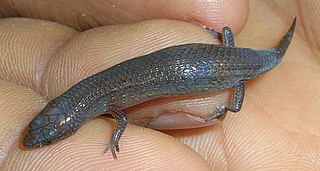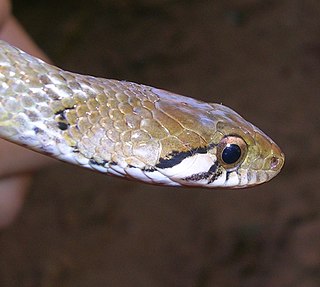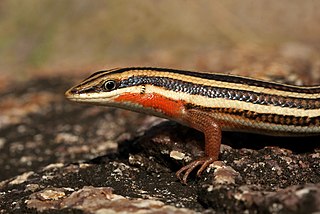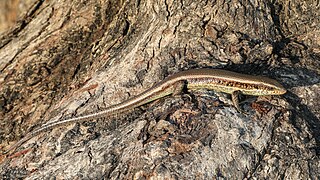
Ristella is a genus of skinks, lizards in the family Scincidae. The genus is endemic to the Western Ghats of southwestern India. Member species are commonly known as cat skinks because of their retractile claws. This genus can be instantly identified by the presence of only four fingers in forelimbs in all the species. All the members look more or less similar, and are drab dark brown to blackish in colouration, with paler undersides. This poorly known group of lizards is diurnal, insectivorous, terrestrial to semi-fossorial in habits. They inhabit deep leaf-litter and grasslands in montane forests and rainforests.
Colonel Richard Henry Beddome was a British military officer and naturalist in India, who became chief conservator of the Madras Forest Department. In the mid-19th century, he extensively surveyed several remote and then-unexplored hill ranges in Sri Lanka and south India, including those in the Eastern Ghats such as Yelandur, Kollegal, Shevaroy Hills, Yelagiri, Nallamala Hills, Visakhapatnam hills, and the Western Ghats such as Nilgiri hills, Anaimalai hills, Agasthyamalai Hills and Kudremukh. He described many species of plants, amphibians, and reptiles from southern India and Sri Lanka, and several species from this region described by others bear his name.

The Nilgiri keelback, also known commonly as Beddome's keelback, is a species of snake found in the Western Ghats in India. The species is named after Richard Henry Beddome, 1830–1911, British army officer and naturalist. It was first discovered near the Nilgiris but is now known more widely from the Western Ghats. This snake is terrestrial and feeds on toads.

Sibynophis collaris, commonly known as the common many-toothed snake,Betty's many toothed snake or the collared black-headed snake, is a species of colubrid snake endemic to South and East Asia.
Uropeltis beddomii, commonly known as Beddome's earth snake, is a species of snake in the family Uropeltidae. The species is endemic to India.

Ophisops jerdonii, commonly known as Jerdon's cabrita, Jerdon's snake-eye, or Punjab snake-eyed lacerta, is a species of lacertid lizard, which is distributed in east Afghanistan, Pakistan, and India.
The big-eared lipinia is a species of skink in the family Scincidae. It is endemic to the Andaman and Nicobar Islands of India.
The white-spotted supple skink is a species of diurnal, terrestrial, insectivorous skink found in parts of tropical Asia. This species was first described by John Edward Gray based on type specimen collected by T. C. Jerdon from Madras, in the Coromandel Coast of South India.

Riopa punctata, also known as the common dotted garden skink, common snake skink, punctate supple skink, or spotted supple skink is a species of skink found in Bangladesh, India, Nepal, Pakistan, Vietnam and Sri Lanka.

Eutropis bibronii, also known commonly as Bibron's mabuya, Bibron's skink, and the seashore skink, is a species of lizard in the family Scincidae. The species is native to India and Sri Lanka.
Blanford's mabuya ( is a species of skink found in peninsular India.

Eutropis multifasciata, commonly known as the East Indian brown mabuya, many-lined sun skink, many-striped skink, common sun skink or (ambiguously) as golden skink, is a species of skink.

Sharma's mabuya is a species of skinks found in India. It was described by Sharma (1969) from hills south of Vijaypuri on the right bank of the river Krishna in Andhra Pradesh.

Eutropis rugifera, variously known as Nicobar Island skink or rough-scaled sun skink, is a species of skink from southeastern Asia.

Eutropis tytleri is a species of skink, a lizard in the family Scincidae. The species is endemic to the Andaman Islands, India.
Ophiomorus tridactylus, commonly known as the three-toed snake skink, is a species of skink endemic to sandy desert areas of South Asia. It is also called the Indian sand-swimmer for its habit of moving just under the sand.
Ristella beddomii, commonly known as Beddome's cat skink and Beddome's ristella, is a species of skink, a lizard in the family Scincidae. The species is native to southwestern India.

Sphenomorphus indicus is a species of skink.

Eutropis is a genus of skinks belonging to the subfamily Mabuyinae. For long, this genus was included in the "wastebin taxon" Mabuya; it contains the Asian mabuyas. They often share their habitat with the related common skinks (Sphenomorphus), but they do not compete significantly as their ecological niches differ. This genus also contains the only member of the subfamily to occur in Australasia, the many-lined sun skink, whose wide range includes New Guinea.

Kaestlea beddomii, also known as Beddome's ground skink, is a species of lizard in the family Scincidae. The species is endemic to the Western Ghats of India.













